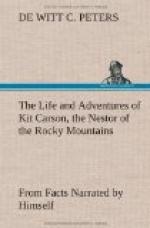While on their march, news was brought in by their spies that a strong command of Mexican Californians had taken up a position on their route, evidently awaiting their advance with the view of attacking them. This occurred on the sixth day of the same month. General Kearney made no change in his route, but advanced to within fifteen miles of the enemy’s encampment. Here he commanded a halt. A reconnoitering party, consisting of fifteen dragoons, commanded by Lieutenant Hammond, was sent on in advance to note the position and force of the enemy. He proceeded upon the duty, but was discovered by the Mexicans. Nevertheless, he fortunately succeeded in making his observations previous to being seen. His report to General Kearney, among other facts, stated that these Mexican soldiers had strongly established themselves in an Indian village.
General Kearney determined, without delay to attack them. Orders were given to resume the march; and, by one o’clock the next morning the American soldiers had fastened all their packs on their mules, and were themselves mounted and ready for the command to move. The order came without delay, and the little army was immediately in motion. Fourteen miles of the space which separated the two parties were passed without interruption. When within one mile of the Mexican position, the advance guard of the Americans suddenly came upon a small advance guard of the Mexicans, who were evidently posted to watch their approach and guard the road. As soon as they were discovered, the trumpets of the dragoons sounded, in quick succession, the orders to trot, and to gallop. The Americans were so prompt in making their charge that they came upon the Mexicans, when a sharp skirmish ensued, in which several of the enemy were killed. The remainder of the outpost were driven in, bearing the news of the attack to their friends. Captain Johnson, Kit Carson and fifteen American soldiers formed the attacking party in this affair. They had been ordered to secure the loose animals belonging to the enemy. In this they failed, the animals being too strongly guarded, and because, upon the first alarm, they were driven out of harm’s way.
This attack, however, proved to be the commencement of a serious fight. Seeing that his orders could not be obeyed in regard to the animals of the enemy, Captain Johnson and his party joined a party under Captain Moore. The force of the latter consisted of twenty-five American volunteers from California, who had attached themselves to General Kearney’s command since its arrival in the country. Moore’s command also comprised parts of two companies of United States dragoons. Captain Moore had been ordered to make an attack on the centre of the enemy, in order to cut their forces in two, and thereby cause confusion in their ranks. As has been stated, Captain Johnson, with his little force, joined Captain Moore in making this attack. While the charge was in progress,




